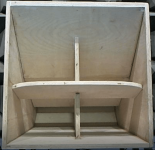So im writing a Uni dissertation on different measurement methods, environments and techniques for loudspeaker horns particularly low frequency horns.
The classic and easiest method for accurately measuring low frequency is nearfield measurements very near the driver, this of course doesn't account for baffle step and so over compensates low frequency content in the measurement and so makes it inaccurate, this can be compensated for when dealing with a standard loudspeaker system via several softwares and excel sheets like Jeff Bagbys baffle step correction sheet or i believe there is something similar in virtuixCAD.
Since I am comparing loads of different methods and techniques i am aware that the best and properly most accurate way of measuring low frequencies is a windowed outdoor ground plane measurement.
My question is whether these methods for baffle step correction apply the same to a horn where the mouth of the horn is considered to be equal to the e.g the size of the driver.
I may also note I have access to a PU Probe and scan and paint software that can average the pressure across the mouth of the horn?
If anyone has any insight or knowledge on the matter it would be greatly appreciated. Further more if theres any papers out there people know of please send my way.
I have attached photo of horn for reference.
Ollie
The classic and easiest method for accurately measuring low frequency is nearfield measurements very near the driver, this of course doesn't account for baffle step and so over compensates low frequency content in the measurement and so makes it inaccurate, this can be compensated for when dealing with a standard loudspeaker system via several softwares and excel sheets like Jeff Bagbys baffle step correction sheet or i believe there is something similar in virtuixCAD.
Since I am comparing loads of different methods and techniques i am aware that the best and properly most accurate way of measuring low frequencies is a windowed outdoor ground plane measurement.
My question is whether these methods for baffle step correction apply the same to a horn where the mouth of the horn is considered to be equal to the e.g the size of the driver.
I may also note I have access to a PU Probe and scan and paint software that can average the pressure across the mouth of the horn?
If anyone has any insight or knowledge on the matter it would be greatly appreciated. Further more if theres any papers out there people know of please send my way.
I have attached photo of horn for reference.
Ollie
Attachments
Your attached photo has no size reference, but I'd guess is under one square meter in size.
Outdoors, the measurement mic would be in the far field in under 2 meters.
https://www.prosoundtraining.com/2010/06/28/far-field-criteria-for-loudspeaker-balloon-data/
Pat Brown wrote :
"It is often thought that a remote measurement position is necessary for low frequencies since their wavelengths are long. Actually the opposite is true. It is more difficult to get into the far-field of a device at high frequencies, since the shorter wavelengths make the criteria in Item 4 more difficult to satisfy.
Item 4:
4. The distance from the source where the path length difference for wave arrivals from points on the device on the surface plane perpendicular to the point of observation are within one-quarter wavelength at the highest frequency of interest."
Criteria #4 can be satisfied up to 210Hz for a subwoofer with a one square meter face measured at one meter with a measurement mic on the ground plane.
Outdoors, the measurement mic would be in the far field in under 2 meters.
https://www.prosoundtraining.com/2010/06/28/far-field-criteria-for-loudspeaker-balloon-data/
Pat Brown wrote :
"It is often thought that a remote measurement position is necessary for low frequencies since their wavelengths are long. Actually the opposite is true. It is more difficult to get into the far-field of a device at high frequencies, since the shorter wavelengths make the criteria in Item 4 more difficult to satisfy.
Item 4:
4. The distance from the source where the path length difference for wave arrivals from points on the device on the surface plane perpendicular to the point of observation are within one-quarter wavelength at the highest frequency of interest."
Criteria #4 can be satisfied up to 210Hz for a subwoofer with a one square meter face measured at one meter with a measurement mic on the ground plane.
